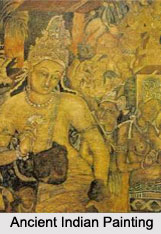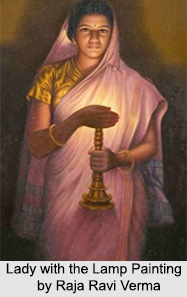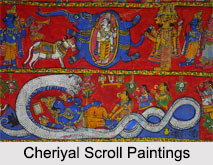 Indian tribal paintings possess an inimitable sensitivity, as tribal folks possess a passionate awareness, massively varying from the urbanised population. India presents before the world perhaps as sunny a field as any solitary country in the world pregnant with a perfect specimen of all the minute varieties of Oriental life; of Oriental scenery, Oriental nations and Oriental manners, and it is open to the globe to explore these peculiarities to the last degree while enjoying perfectly European security. And tribal paintings cater to such Orientalism, inexhaustible charisma of the "others"; a perfect expression of their life redrawing their passion and mystery.
Indian tribal paintings possess an inimitable sensitivity, as tribal folks possess a passionate awareness, massively varying from the urbanised population. India presents before the world perhaps as sunny a field as any solitary country in the world pregnant with a perfect specimen of all the minute varieties of Oriental life; of Oriental scenery, Oriental nations and Oriental manners, and it is open to the globe to explore these peculiarities to the last degree while enjoying perfectly European security. And tribal paintings cater to such Orientalism, inexhaustible charisma of the "others"; a perfect expression of their life redrawing their passion and mystery.
Tribal painting is the mirror of the energy of the respective art of various tribal groups. It is a living and changing art form, which changes with time, necessity, environment, memories, global influences and experiences of these people.
Wall Painting
Wall painting is the simplest art in any tribal society. The custom of making designs on walls and floors for some festivals or other religious purposes is common in the Indian tribal scenario. Every year when they repair or whitewash their surroundings, they either recreate a fresh design or recreate the previous one with fresh colours.
Tribal Painting of different regions of India
The Saura painting of Odisha which is done by the `Sauras` is one of the important paintings of the eastern zone which consists of sublime portraiture of human beings, horse, elephant and sun with symbolic meanings behind each. Painted to appease the Gods and ancestors, these paintings are noted for their elegance, charm, iconography, aesthetic and ritualistic association. This form of art is mostly found in Rayagada district, Gajapati district and Koraput of Odisha.
Another Indian tribal art of eastern zone is Santhal Painting which is portrayed by Santhal tribes, located in Bihar, Odisha and West Bengal. It is painted freehand and reflects their perception of life. This painting possesses the simplest themes like harvesting, field, happy family, dance, domestic violence, quarrel, wine party, Gods and Goddess on the canvas. They are done on a handmade paper with poster colors. The Khovar and Sohrai paintings occupy a significant part in the tribal art of India. Khovar is the mural art form practiced by tribal women artists during the marriage season from January to June. The term Khovar is a popular term for the painted rock art caves across India.
The Khovar is the Bridal Room where the decorated nuptial room is a tribal tradition. The decoration is done in the bride`s house by the bride`s mother. These two forms of Indian tribal painting redraw Indian illustrious lines in painting and artistic lineage. Kurmi villagers are close to the rock art sites. Tigers and elephants are common motifs in their form of Indian tribal painting along with peafowl and the legendary man-like bird Chibha which runs on legs and stands upright and has hands. This art is colorful, vibrant and evocative, reminiscent of the natural expression of people.
Indian tribal art had developed in the western zone of India. The popular tribal art forms of India include Warli Painting and Pichhwai Painting. Among the tribal paintings, Warli painting is a tribal art form of southern Gujarat and northern Maharashtra. The surface of their wall is coated with a paste of cow-dung and then a coating of gheroo is applied. Once this dries, the process of painting begins. The Warlis use wooden sticks as brushes for their paintings. This form of Indian tribal painting possesses different human art forms like hunting, dancing or land cultivating, geometrical patterns of trees, creepers, birds, and animals.
The Indian tribal art incorporates the artistic exuberance of the tribal people of Central India where Pithora Painting, Mandana wall and floor painting, Gond and Bondi Paintings exhibit grand superiority of the states like Madhya Pradesh and some parts of Gujarat. Pithora is the name of the wedding patron God in Madhya Pradesh and Gujarat. It is thus regarded auspicious to paint the house walls with images of the deity during family functions like weddings. Pithora is the name of the wedding deity amongst the Rathwa Bhils of Madhya Pradesh and Gujarat. There it is a common practice to install a deity during weddings or on other auspicious occasions at home in the form of a ritual wall-painting. Hence the name, Pithora, as this is the subject of all paintings of this style of art. This form of Indian tribal painting is made inside a sacred enclosure. Malwa, Nimar and Tanwarghar regions of Madhya Pradesh are known for their Mandana wall and floor painting traditions.



















